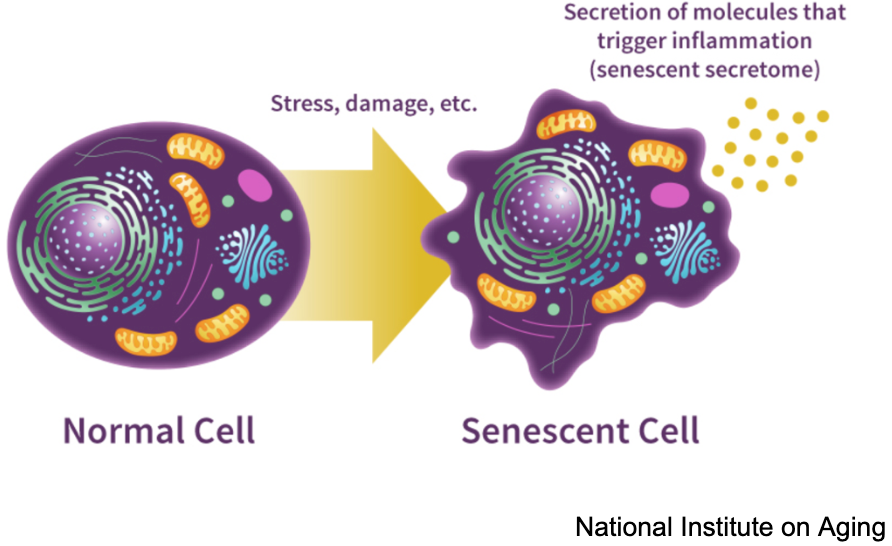As humans, we all have the desire to live long and healthy lives. So imagine extending your lifespan and reducing the risk of age-related diseases by taking a pill. Sounds too good to be true? Enter senolytics, a new class of drugs that could hold the key to unlocking the secret of longevity. Scientists have been working on this groundbreaking research for years, and the results have been promising. But before we dive into the details of how senolytics work and why they’re essential for longevity, let’s look at a story that shows the potential of these drugs.
A 75-year-old woman, who has had arthritis for years, was given senolytics treatment. Within weeks, she could move without pain and resume her daily activities. This miraculous recovery was due to the removal of senescent cells, causing inflammation and damage in her joints. But the question remains, can senolytics do more than just treat arthritis? Let’s find out.
Senolytics and Senescent Cells
Senescent cells, or cells that have stopped dividing but have not died, accumulate in our bodies as we age. These cells have the ability to release harmful substances that cause inflammation and damage to surrounding tissues, thus contributing to a variety of age-related diseases. Senolytics are a new class of drugs that target and eliminate senescent cells in the body. Senolytics has emerged as a promising area of research for increasing longevity and healthspan in recent years.
The presence of senescent cells has been linked to various age-related diseases, including cancer, cardiovascular disease, and neurodegenerative disease. Furthermore, these cells release inflammatory molecules, which contribute to chronic inflammation and tissue damage. Senolytics work by selectively removing senescent cells from the body and improving tissue function.

Research On Senolytics Benefits
Several studies in mice have shown that senolytics can improve health and extend lifespan. For example, one study found that treatment with senolytics improved cardiovascular function and reduced frailty in old mice. In contrast, another study found that senolytics improved kidney function and reduced the risk of age-related diseases in mice. These results suggest that senolytics have broad benefits for improving health and longevity.
Recent research has also uncovered new potential benefits of senolytics. For example, one study found that senolytics may reverse age-related hair loss by targeting senescent cells in hair follicles. Another study found that senolytics may improve immune function in older adults, suggesting that these drugs may have benefits for fighting infections and improving vaccine responses.
Concerns About Senolytics Drugs
Despite these promising results, there is still much to learn about senolytics and their effects on longevity. Some researchers have raised concerns about potential side effects of senolytics, such as impaired wound healing and increased risk of cancer. Additionally, more research is needed to determine the optimal dosing and timing of senolytics for maximum benefits.
Conclusion
In summary, senolytics are a groundbreaking class of drugs that have the potential to extend human lifespan and improve health in old age. By targeting and eliminating senescent cells, these drugs can alleviate age-related disorders such as arthritis, cancer, and cardiovascular disease. Our 75-year-old friend’s success story with senolytics is just the tip of the iceberg when it comes to the potential of these drugs. With ongoing research and development, we may be on the brink of unlocking the secret to a longer, healthier life.
Stay tuned for our next article on the latest breakthroughs in senolytic research, and learn how this cutting-edge field could revolutionize the way we age.
Al Keky, Staff Writer @ Montecito Concierge Medicine
Scientific Writer I Health & Nutrition Life Coach
References:
- Clearance of p16Ink4a-positive senescent cells delays ageing-associated disorders. Nature, 479(7372), 232-236.
- The Achilles’ heel of senescent cells: from transcriptome to senolytic drugs. Aging cell, 14(4), 644-658.
- JAK inhibition alleviates the cellular senescence-associated secretory phenotype and frailty in old age. Proceedings of the National Academy of Sciences, 115(40), E9271-E9278.
- Effects and Related Mechanisms of the Senolytic Agent ABT-263 on the Survival of Irradiated A549 and Ca9-22 Cancer Cells.
- Effects of Fisetin, a Plant-Derived Flavonoid, on Response to Oxidative Stress, Aging, and Age-Related Diseases in Caenorhabditis elegans

